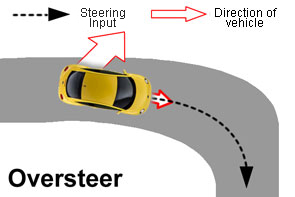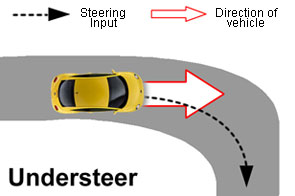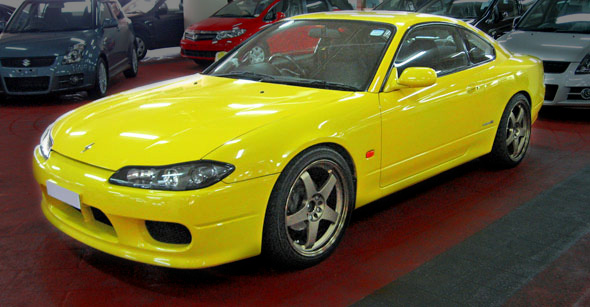Understeering and oversteering
01 Sep 2007|56,211 views
A well designed car does not suddenly break into a skid. As the tyre approach their traction limits, they tend to slip sideways across the road. The angle between the tyres' actual path and its natural path is called its slip angle. This gives the driver advance warning that the front/rear of the car is in danger of breaking loose and starting to skid.
If the rear tyres approach their traction limit more rapidly than the front, the rear of the car will steer a wider path than the front wheels. This rotates the car more than the driver intended and, if nothing is done, leads to the car turning a smaller radius corner. When this occurs, the car is said to oversteer.
If the front tyre approach the traction limit more rapidly, the effect is that the front of the car takes a wider radius curve than the driver intended. The car is said to understeer.
Understeer is safer than oversteer. If the car understeers, and no correction is made, the result is a wider corner than intended. The car remains stable. If the car oversteers, the turn made has smaller radius than intended. The smaller radius produces higher cornering forces, bringing the required traction even closer to the limit of the rear wheels, thus causing even more oversteer. The situation will worsen until the rear wheels lose total grip; the car spins and all directional control is lost.
What is oversteer
Oversteer is when the car turns more than expected. It is a phenomenon whereby the rear tyres lose its traction before the front wheel during cornering. This causes the rear of the vehicle to slide towards the outside of the corner, thereby creating a feeling that the car is trying to spin.
Rear wheel drive vehicle are more prone to oversteer. This is because the rear tires must handle both the lateral cornering force and engine torque, resulting in the rear tyres approaching their traction limit more rapidly. Oversteer can be quite dangerous as it can land the car in a spin.
What to do when your vehicle oversteer
Many drivers instinctively slam on the brakes when the vehicle begins to oversteer. Slamming the brakes will only aggravate the situation, causing the rear tyres to lose more traction. The correct reaction is to reduce the steering angle gently and lift off the accelerator.
What is understeer
Understeer is when the car turns lesser than expected. It is a phenomenon whereby the front tyres lose its traction before the rear tyres during cornering.
Front wheel drive vehicle are more prone to understeer. This is because the front tyres must handle both the lateral cornering force and engine torque. This results in the front tyres approaching their traction limit more rapidly.
What to do when your vehicle understeer
Many drivers instinctively increase the steering angle when their vehicles understeer. Increasing the steering angle increases the cornering force, making the front tyres lose traction completely. The correct reaction is to lift off the accelerator and apply the brakes. By doing that, more weight is transferred to the front tyres to give them grip.
Drifting
Drifting is a popular motor sport whereby drivers intentionally induce oversteer through corners. Drivers are judged on their drifting technique instead of the time taken to complete the race.
If the rear tyres approach their traction limit more rapidly than the front, the rear of the car will steer a wider path than the front wheels. This rotates the car more than the driver intended and, if nothing is done, leads to the car turning a smaller radius corner. When this occurs, the car is said to oversteer.
If the front tyre approach the traction limit more rapidly, the effect is that the front of the car takes a wider radius curve than the driver intended. The car is said to understeer.
Understeer is safer than oversteer. If the car understeers, and no correction is made, the result is a wider corner than intended. The car remains stable. If the car oversteers, the turn made has smaller radius than intended. The smaller radius produces higher cornering forces, bringing the required traction even closer to the limit of the rear wheels, thus causing even more oversteer. The situation will worsen until the rear wheels lose total grip; the car spins and all directional control is lost.
What is oversteer

Oversteer is when the car turns more than expected. It is a phenomenon whereby the rear tyres lose its traction before the front wheel during cornering. This causes the rear of the vehicle to slide towards the outside of the corner, thereby creating a feeling that the car is trying to spin.
Rear wheel drive vehicle are more prone to oversteer. This is because the rear tires must handle both the lateral cornering force and engine torque, resulting in the rear tyres approaching their traction limit more rapidly. Oversteer can be quite dangerous as it can land the car in a spin.
What to do when your vehicle oversteer
Many drivers instinctively slam on the brakes when the vehicle begins to oversteer. Slamming the brakes will only aggravate the situation, causing the rear tyres to lose more traction. The correct reaction is to reduce the steering angle gently and lift off the accelerator.
What is understeer

Understeer is when the car turns lesser than expected. It is a phenomenon whereby the front tyres lose its traction before the rear tyres during cornering.
Front wheel drive vehicle are more prone to understeer. This is because the front tyres must handle both the lateral cornering force and engine torque. This results in the front tyres approaching their traction limit more rapidly.
What to do when your vehicle understeer
Many drivers instinctively increase the steering angle when their vehicles understeer. Increasing the steering angle increases the cornering force, making the front tyres lose traction completely. The correct reaction is to lift off the accelerator and apply the brakes. By doing that, more weight is transferred to the front tyres to give them grip.
Drifting
Drifting is a popular motor sport whereby drivers intentionally induce oversteer through corners. Drivers are judged on their drifting technique instead of the time taken to complete the race.
 |
| The Nissan Silvia is a popular drift machine. |
A well designed car does not suddenly break into a skid. As the tyre approach their traction limits, they tend to slip sideways across the road. The angle between the tyres' actual path and its natural path is called its slip angle. This gives the driver advance warning that the front/rear of the car is in danger of breaking loose and starting to skid.
If the rear tyres approach their traction limit more rapidly than the front, the rear of the car will steer a wider path than the front wheels. This rotates the car more than the driver intended and, if nothing is done, leads to the car turning a smaller radius corner. When this occurs, the car is said to oversteer.
If the front tyre approach the traction limit more rapidly, the effect is that the front of the car takes a wider radius curve than the driver intended. The car is said to understeer.
Understeer is safer than oversteer. If the car understeers, and no correction is made, the result is a wider corner than intended. The car remains stable. If the car oversteers, the turn made has smaller radius than intended. The smaller radius produces higher cornering forces, bringing the required traction even closer to the limit of the rear wheels, thus causing even more oversteer. The situation will worsen until the rear wheels lose total grip; the car spins and all directional control is lost.
What is oversteer
Oversteer is when the car turns more than expected. It is a phenomenon whereby the rear tyres lose its traction before the front wheel during cornering. This causes the rear of the vehicle to slide towards the outside of the corner, thereby creating a feeling that the car is trying to spin.
Rear wheel drive vehicle are more prone to oversteer. This is because the rear tires must handle both the lateral cornering force and engine torque, resulting in the rear tyres approaching their traction limit more rapidly. Oversteer can be quite dangerous as it can land the car in a spin.
What to do when your vehicle oversteer
Many drivers instinctively slam on the brakes when the vehicle begins to oversteer. Slamming the brakes will only aggravate the situation, causing the rear tyres to lose more traction. The correct reaction is to reduce the steering angle gently and lift off the accelerator.
What is understeer
Understeer is when the car turns lesser than expected. It is a phenomenon whereby the front tyres lose its traction before the rear tyres during cornering.
Front wheel drive vehicle are more prone to understeer. This is because the front tyres must handle both the lateral cornering force and engine torque. This results in the front tyres approaching their traction limit more rapidly.
What to do when your vehicle understeer
Many drivers instinctively increase the steering angle when their vehicles understeer. Increasing the steering angle increases the cornering force, making the front tyres lose traction completely. The correct reaction is to lift off the accelerator and apply the brakes. By doing that, more weight is transferred to the front tyres to give them grip.
Drifting
Drifting is a popular motor sport whereby drivers intentionally induce oversteer through corners. Drivers are judged on their drifting technique instead of the time taken to complete the race.
If the rear tyres approach their traction limit more rapidly than the front, the rear of the car will steer a wider path than the front wheels. This rotates the car more than the driver intended and, if nothing is done, leads to the car turning a smaller radius corner. When this occurs, the car is said to oversteer.
If the front tyre approach the traction limit more rapidly, the effect is that the front of the car takes a wider radius curve than the driver intended. The car is said to understeer.
Understeer is safer than oversteer. If the car understeers, and no correction is made, the result is a wider corner than intended. The car remains stable. If the car oversteers, the turn made has smaller radius than intended. The smaller radius produces higher cornering forces, bringing the required traction even closer to the limit of the rear wheels, thus causing even more oversteer. The situation will worsen until the rear wheels lose total grip; the car spins and all directional control is lost.
What is oversteer

Oversteer is when the car turns more than expected. It is a phenomenon whereby the rear tyres lose its traction before the front wheel during cornering. This causes the rear of the vehicle to slide towards the outside of the corner, thereby creating a feeling that the car is trying to spin.
Rear wheel drive vehicle are more prone to oversteer. This is because the rear tires must handle both the lateral cornering force and engine torque, resulting in the rear tyres approaching their traction limit more rapidly. Oversteer can be quite dangerous as it can land the car in a spin.
What to do when your vehicle oversteer
Many drivers instinctively slam on the brakes when the vehicle begins to oversteer. Slamming the brakes will only aggravate the situation, causing the rear tyres to lose more traction. The correct reaction is to reduce the steering angle gently and lift off the accelerator.
What is understeer

Understeer is when the car turns lesser than expected. It is a phenomenon whereby the front tyres lose its traction before the rear tyres during cornering.
Front wheel drive vehicle are more prone to understeer. This is because the front tyres must handle both the lateral cornering force and engine torque. This results in the front tyres approaching their traction limit more rapidly.
What to do when your vehicle understeer
Many drivers instinctively increase the steering angle when their vehicles understeer. Increasing the steering angle increases the cornering force, making the front tyres lose traction completely. The correct reaction is to lift off the accelerator and apply the brakes. By doing that, more weight is transferred to the front tyres to give them grip.
Drifting
Drifting is a popular motor sport whereby drivers intentionally induce oversteer through corners. Drivers are judged on their drifting technique instead of the time taken to complete the race.
 |
| The Nissan Silvia is a popular drift machine. |












